You may not be a golfer or a fan of golf, but I am sure you have heard of Tiger Woods. He has been ranked the number one golfer in the world many times. However, in the last few years, we have seen Woods withdraw from many tournaments due to pain or injury.
Last year, Woods underwent a microdiscectomy, which sidelined him for most of the season. In his first event of 2015, he withdrew due to back pain. In his second event of the season, he withdrew after eleven holes. He was quoted as saying, “My glutes are shutting off, then they don’t activate and then, hence, it [pain] goes into my lower back. I tried to activate my glutes as best I could, in between, but they never stayed activated.”
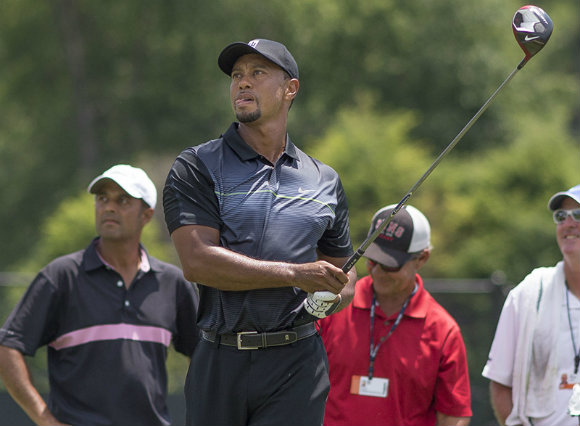
The public and media have made this statement into a bit of a butt joke. However, for those of us in the strength and conditioning community, we run into gluteal amnesia on a regular basis. Gluteal amnesia is a real thing. It refers to an inhibition or delayed activation of the gluteal muscles, which can lead to weakness of the muscles over time and the recruitment of other muscle groups to perform the function of the glutes.
The glutes play an important role in hip extension, stabilization of the pelvis, and positioning of the legs. All important things in the game of golf, and all things that can be addressed with a proper strength and conditioning program.
Golf Fitness Training
The community of SFG Certified professionals applies the kettlebell to very diverse populations: everyone from MMA fighters and tactical athletes to people who want to get in better shape. I use the SFG principles along with kettlebells, barbells, and progressive bodyweight movements to increase performance for golfers.
Kettlebells and training for golf performance are a perfect match. Get-ups, deadlifts, squats, presses, pull-ups, swings, snatches, bent presses, windmills, and all of the other standard StrongFirst movements are a fantastic recipe for improving golf performance.

Golf fitness training has become more mainstream over the last decade due to the Titleist Performance Institute (TPI), which has a golf specific screening process. For those of you who don’t know, TPI combines the expertise of the medical professional, golf coach, and fitness professional. This provides the golf athlete with treatment for pain, concepts for swing and game development, and strength and conditioning to eliminate movement dysfunction, asymmetries, and limitations.
Often a biomechanical limitation prevents a golfer from efficiently performing the golf swing. Once limitations are removed, a golfer will have a better chance of making changes to their golf swing and eliminating swing faults. The TPI certifications are very compatible with the FMS screen.
Training for Golf Doesn’t Have to Be Complicated
We can all agree that golf is a rotational sport, but sometimes doing more rotation doesn’t provide your body with the adaptations it needs to make your swing better. Does it have to look like golf to improve your golf game? Of course not, but many of the exercises that are presented in the media to golfers are rotational movements because little explanation is needed to communicate their likely positive benefit to the golf swing.
Training for golf does not need to be over complicated with 26 different rotational movements tied up with stretchy bands. Squats may seem like a generic movement with little carryover, but the benefits to your swing and your daily movement patterns are numerous.
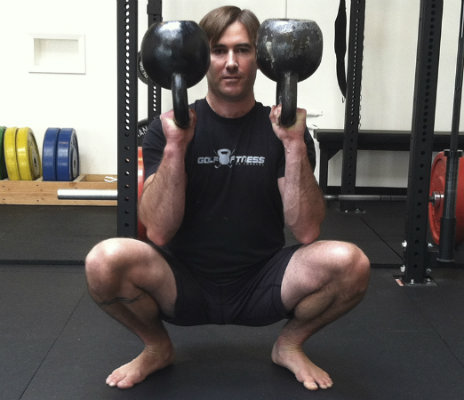
If you have a loss of posture in your golf swing, learning to squat could be the secret ingredient to being able to maintain your posture through impact. If you cannot maintain posture in your golf swing, working on hand position or creating more lag is just a waste of time. TPI has connected early extension (losing your posture toward the ball) to the inability to overhead deep squat. If you are an FMS practitioner, this should be a light bulb moment. The SFG/FMS professional might not realize they already have all of the tools to work on golf performance, and just need to connect the dots.
Enter Turkish Get-ups
Could there be a more golf specific exercise than the get-up that also restores functional movement qualities? A well done get-up should be deliberate and graceful. It incorporates reaching, rolling, separating the upper and lower body, scapular stability, cervical mobility, thoracic mobility, trunk stability, stepping pattern, hip hinging, and grip strength. It is also a movement that can help restore left and right symmetry to the body. This is an important benefit to golfers because the golf swing is a repetitive and violent asymmetrical movement.
But what if you need mobility? The get-up does that, too. What if you have mobility, but need more stability? Well, you’re in luck, the get-up does that, as well. The get-up makes you strong and flexible. It will open your hips, improve rotator cuff function, enable a better hip hinge, and make you a cup of coffee while you are switching the bell to the other side (well maybe not, but it sure does provide many benefits.).
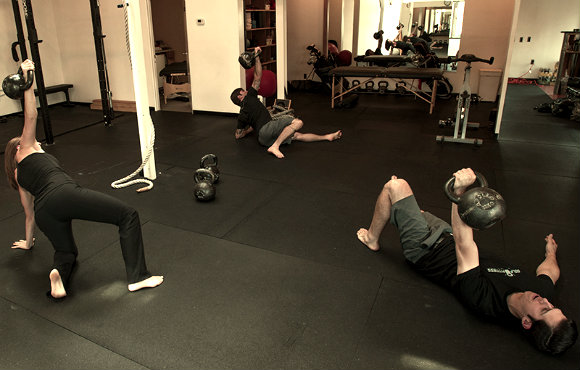
The get-up is a contralateral pattern that involves tremendous proprioception, much like your golf swing. It makes for great movement prep prior to playing a round, and it provides a good bang for your buck when budgeting time for exercise. If you were to visit us here at Golf Fitness Los Angeles, you will likely see someone doing a get-up or pieces of one in preparation for lifting, to address a limitation, and of course to build a heavier get-up. Any SFG Certified kettlebell instructor can teach the subtleties of mastering this movement.
Grip Training and Scapular Stability
The more grip strength an athlete is able to produce, the more activation he or she will get in the rotator cuff. Doing exercises that put a demand on the grip has a strength-building effect on the muscles of the cuff, which are important to golf because they stabilize the shoulder as it goes through flexion, extension, abduction, adduction, and internal/external rotation. Many shoulder injuries happen due to scapular instability.
Thankfully, you just can’t use a kettlebell properly without growing your grip strength. Improved grip strength will improve power output at impact and clubface control at the top of the back swing.
Additionally, a limitation in T-spine mobility will force an athlete to compensate by destabilizing the cuff to rotate with it in place of the T-spine. T-spine functionality goes hand-in-hand with scapular stability. To get the cuff strong and stable, the T-spine it is connected to needs to be able to do its job of extending, flexing, and rotating, which is how it is required to move in the golf swing.
You can do stretchy band internal/external rotations all day (and there is a time and place for that, according to some people), but real scapular stability comes with improving grip strength. Bottoms-up kettlebell carries anyone?
Golf Fitness Training With StrongFirst
These are just a few examples of how StrongFirst methods and tools can benefit the performance needs of the recreational and professional golfer. I am sure I don’t need to mention the value of the kettlebell swing as a powerful hip hinging movement that helps an athlete create greater ground force production. That one is obvious, right? Our tools are versatile across many populations, including golfers.
According to Tiger, he is missing some glute activity. Tiger is doing us all a favor by bringing attention to a concept that is the cornerstone of most of our lifting. My athletes now joke about their glutes being more active than Tiger’s. The kettlebell, the barbell, the pull-up bar, and bodyweight movements can be the best golf performance tools, you just need to be able to communicate to golfers what the connection is to their golf swing.
Golfers quickly come around to our methods. They don’t have flimsy goals. Their goals are always clear, measurable, and generally the same: to hit the ball farther, have a better golf swing, play better golf, and prevent injury. Kettlebells do that.
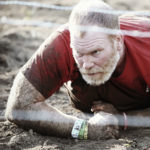
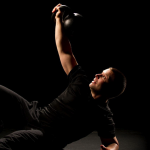
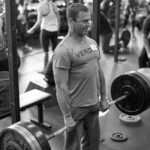
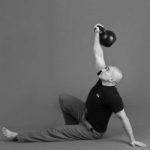

I´ve yet to find anyone to explain so called “gluteal amnesia.” It´s a fancy word that just means that ass is weak. Logically then- deadlifts, swing etc. will work in repairing “gluteal amnesia.”
Just as an aside and some info from memory:
1. The golf swing is more demanding than many realize. The peak glute activation of a professional is equivalent to 5rm.
I’ve witnessed professional’s games go south when required to play two rounds on the same day.
There is a persistent story (provenance unknown) about a golf hustler in the early 20th century who would challenge big drivers to a skins game and just to make it “interesting” offer the opponent two drives per hole – and chose the best drive. Of course the big hitter would give his ALL on the first drive of each hole. It generally worked out that the big hitter’s game went south before #9.
Story may be hearsay – but ask your golfing friends how often they’ve lost their game before #18.
I seems obvious to me that something like the kettlebell swing which combines strength AND endurance in the glutes would be just the ticket for golfers.
Not sure these exercises would help Tiger. The quickness developed by boxing may be a better solution. I think Tiger’s pain is caused by a faulty swing premise. The strain on the body by trying to follow the ball away down line can result in a contortion bad enough to produce his injuries.
Like FreeWeight said, great golfers of the past didn’t do much working out at all except for maybe Gary Player. Strenght and conditioning programs are a very recent thing in golf.
The reason people early extend is because they are way too steep during the down swing (usually chasing lag) and early extending creates their only chance at shallowing out the swing to not bury the club head into the ground behind the ball. Its the bodies natural reaction to a faulty sequence.
TGUs are great though 🙂
We trained few competitive golfers at our gym and we do quite a few TGU, deadlifts and squats without getting too fancy with varieties. And just focusing on getting better movement and techniques in those lifts. And it seems to help them perform better on the golf course based on their feedback. Thanks for this brilliant blog post.
“Learning to squat properly is vital for golf posture”
Did ANY of the golf greats learn to squat properly? Did they squat at all?? I don’t think so.
Dead wrong, Gary Player was famous for pistol squats. Sam Snead was considered to be one of the best athletes to ever play golf. They said he could have played for any pro baseball team. That being said, I’m sure he didn’t know how to squat though.
I’d check with Nicklaus and Palmer and Player on this one.
I’ve notice that the pro golfers have seemed a lot “buffer” over the past few years!